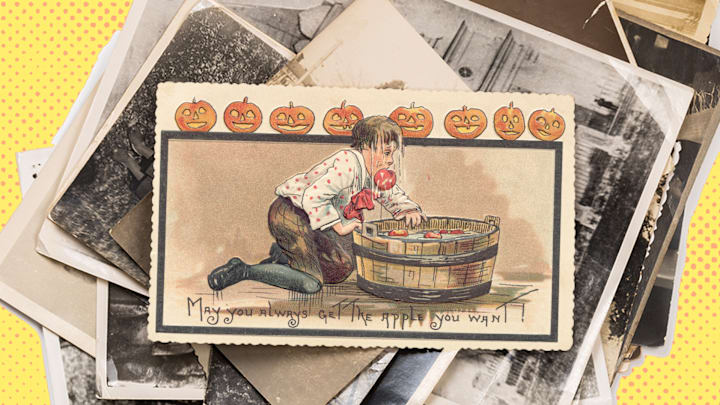You probably know at least one Halloween Grinch—those folks who complain the candy is too expensive, the costumes too sexy, the doorbells too frequently pressed.
Next time they grumble, just tell them that they’re lucky they only have to deal with the modern, relatively tame Halloween, because in decades, the holiday past was much more dangerous, disgusting, and twisted. Behold the hellish history of Halloween.
- People played with fire—literally.
- Instead of candy, “treats” were bitter vegetables or sharp metal objects.
- There were more tricks and fewer treats.
- The costumes were twisted.
- It was tax day in medieval Ireland.
People played with fire—literally.

Do you find bobbing for apples too pleasant? How about a fun game of Snap-Apple? Here’s how you played, according to a 1892 New York Times article that described Halloween customs: You tie a string around the middle of a stick and hang it from the ceiling. You attach an apple on one end of the stick and a lit candle on the other. Then you spin the stick. The goal: Players try to take a bite of the apple while avoiding burning wax and flames in their mouths.
That wasn’t the only fun pastime where people risked searing their flesh. In Trick or Treat: A History of Halloween, author Lisa Morton describes the 1870s American game of Snapdragon, in which kids “try to snatch bits of dried fruit or wrapped fortunes from a dish of flaming alcohol.”
Instead of candy, “treats” were bitter vegetables or sharp metal objects.
In 18th-century Scotland, Halloween wasn’t about candy corn—it was about cabbage and kale. The New York Times described the custom of young Scots going blindfolded into a cabbage field and pulling up the first stalk the felt. “The future partner was bound to be stout or slender, tall or short, according to the stalk selected,” the article notes. “The amount of dirt clinging to the root furnished a suggestion as to dowry or fortune.” You should also taste the stalk to get a sense of the “temper” of your future spouse.
Another delicious Halloween treat: Dried oatmeal and salt. Morton says that nervous parents in 19th-century Northern Ireland rubbed the mixture on the hair of any kid going out on Halloween to protect them from evil faeries.
Perhaps the least fun Halloween snack of all? A sharp needle in your mouth. According to our own Mental Floss archives, Victorian Halloween celebrants would bake cakes containing a needle, thimble, dime, or ring. If your cake had a needle or thimble, that meant you were destined for a life of spinsterhood (which meant a lot of time to sew). A dime or a ring meant you’d be married or get rich.
There were more tricks and fewer treats.

In Halloweens of yore, the so-called “tricks” were often another name for vandalism and violence. According to History.com, one popular prank involved sticking a burning cabbage in the victim’s keyhole to fill their house with foul-smelling smoke. Halloween pranksters also liked to set cattle free to roam the town or knock over (sometimes occupied) outhouses. Or how about the hilarious 1918 prank in which kids coated streetcar tracks with candle wax, leading to a crash and a seriously injured a woman? And then there was the 1907 Tucson, Arizona, prank in which jokesters put a tripwire across the sidewalk in front of a store. When the owner came out and tripped over the wire, he expressed his displeasure by shooting one of the pranksters, who died.
The costumes were twisted.

In Victorian England, adult Halloween revelers went door to door carrying a “Hobby Horse.” As author Morton describes it, the Hobby Horse consisted of a “real horse’s skull mounted atop a staff” carried by someone draped in animal skin. In Scotland at the time, people might also burn an effigy of a witch.
The 18th-century Irish had a custom of donning suits of white straw and conical hats, then “engaged in wild pranking and petty vandalism (especially stealing food) directed mainly at families who kept their daughters from the company of boys,” Morton writes.
Also, the seemingly adorable bedsheet ghost costume has a disturbing origin story. It was often used by criminals to fleece victims or as a way to terrorize or sexually assault women in Britain in the 17th, 18th, and 19th centuries, according to this Mental Floss piece by Lucas Reilly.
It was tax day in medieval Ireland.
Maybe giving out Snickers to kids can be annoying—but it probably beats paying you taxes. The pagan holiday that many consider to be the precursor of Halloween, Samhain, began at sundown on October 31. As part of Samhain, according to Morton, Celtic families had to extinguish their home fires. They then had to shlep to Tlachtga—where the Druids had built a bonfire—pay their taxes, and get an ember to re-light their hearths. Trick or treat was more like tax or punishment. Fun.
Read More About the Bad Old Days:
